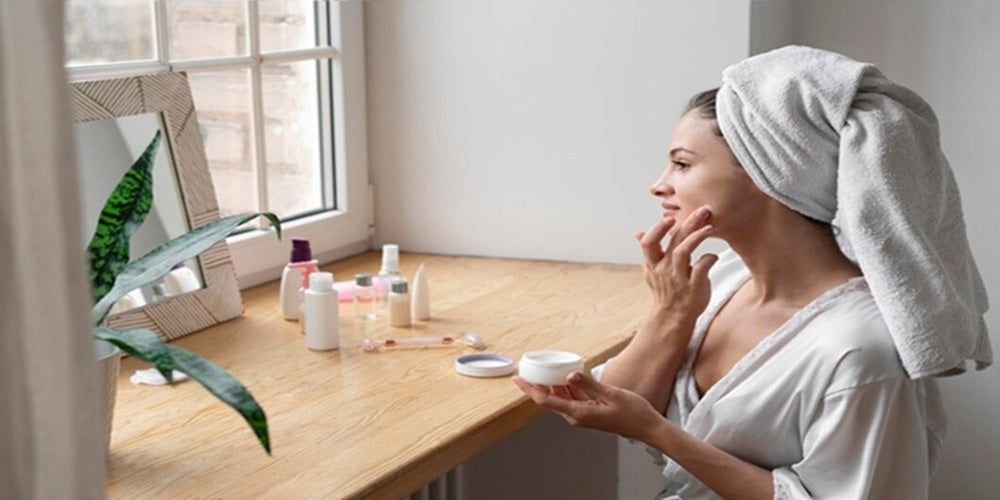
Blemishes and patches on the skin can be very bad for your complexion and skin tone. Patchy skin can be a sign of malnourished and dehydrated skin. Sometimes, white patches on the face can come up because of sun exposure or some kind of infection. In case the white patches do not go away with topical treatments, you should go to a dermatologist.
There are many creams and ointments that can treat patchy skin or white spots. White spots on the face can be a serious concern, and you need to treat them as soon as you see them. Instead of going for home remedies, it is best to choose skin treatment creams from our brand after consulting with your dermatologist.
Why do white spots appear on the skin?
There could be many reasons why white spots arise on your face. When you see such spots on your face, you should get professional advice and treat them properly. Firstly, you need to understand the cause of these spots and then treat them by applying topical treatments or avoiding the cause.
1> Peeling from sun rays
Sun rays can damage the delicate skin on your face. One white spot on the face reason is because of exposure to harsh sun rays. Sun rays can penetrate your facial skin and damage the skin layers. This can cause pigmentation and sometimes peeling of skin that leads to white spots and patches. If you have gone on vacation and are exposed to sun rays most of the time, it can cause peeling of the skin, exposing the layers and causing white patches.
When you learn that the white patches are a result of sun exposure, you need to invest in a good moisturiser and hydrating sunscreen that protects the skin from further damage. You can use the Derma Fresh Face Cream for dry skin as a moisturiser and then top it with the SPF 60 anti-ageing sunscreen to protect your skin.
2> Mycosis
Another reason for white marks on the face is mycosis. Mycosis is a type of fungal infection that can lead to a patchy look on your skin. The difference between simple white patches and fungal patches is that these patches are itchy and can spread to other parts of your body. These spots can also increase if your skin is overexposed to sun rays.
The fungus that causes such kinds of spots lives on your skin but multiplies when you do not clean your skin and take care of it. We do not have medicated creams for mycosis, but a dermatologist can help you cure the condition. Ketoconazole can be helpful as a drug against fungal infections on the skin.
3> Eczema
Eczema can be a reason you have white spots on your skin. Eczema can arise on your skin when your skin is inflamed and dehydrated. To keep your skin hydrated, you need to drink enough water. You should also use a steroidal cream to reduce the eczema signs on your skin. Apart from this, your dermat might need an antihistamine spray to reduce the inflammation on your face.
Moreover, you can secure the hydration level of your face by using a hydrating moisturiser. You can use hydrating serums like Squalane facial oil that keep the moisture locked in your skin layers. During the treatment of eczema, you should use Chamomile Sensitive face wash for your skin to keep your face clean and calm.
4> White freckles
You might also get white freckles that can look like white spots on your skin. If you are a person with fair skin, you might get some white freckles as you age. These white freckles can appear on your face and other parts of the body. This is a normal sign of ageing, and you should get used to it. However, as your face matures, you should take care of your skin.
For example, you should use Vitamin A Night Repair cream for ageing skin. This will reduce your wrinkles and fine lines. This cream might also reduce the appearance of freckles on your skin. Apart from using a good night cream, you should use a higher-powered sunscreen when going out to prevent premature ageing of your skin.
5> Hypomelanosis
Hypomelanosis is a condition that means there is less production of melanin from your body, and because of this, white spots and patches might appear on your body. Hypomelanosis can arise for some internal reason, and you should go to your dermatologist if this happens. However, you can also reduce the effect of hypomelanosis by reducing your exposure to the sun.
Moreover, you can also reduce the effect of sun rays by using a good physical or chemical sunscreen. A mattifying gel-cream sunscreen from our collection with SPF 50 gives you hydration and protects you from the skin condition of losing pigment. Regular sunscreen use can protect you from white patches. Moreover, you should keep most parts of your body covered when heading out to stop patches on other parts of the body.
6> Nutritional deficiency
Apart from what you apply to your face, what you eat also makes a difference to the condition of your face. Nutritional deficiency and improper diet can show up on your face as acne, pimples or patches.
The deficiency of calcium or vitamin D can also lead to white patches on the skin. You should drink more milk and eat calcium-rich foods to keep your skin healthy and spotless. You can also eat some natural skin supplements to protect your skin from any kind of blemishes.
Conclusion
Patches on the skin and white spots can affect your skin to a great extent and create imperfections on your face. You should get treated for white patches and spots after proper diagnosis. If you see minor white spots, you can use our products to target the pigmentation on your face.
Sometimes, people are unable to see white spots on their faces until it is too late. People should always pay attention to their skin and use good quality skin care products to maintain their health. You should also use dermatologically tested face washes and creams to make sure the face does not have any inflammation or infection.








